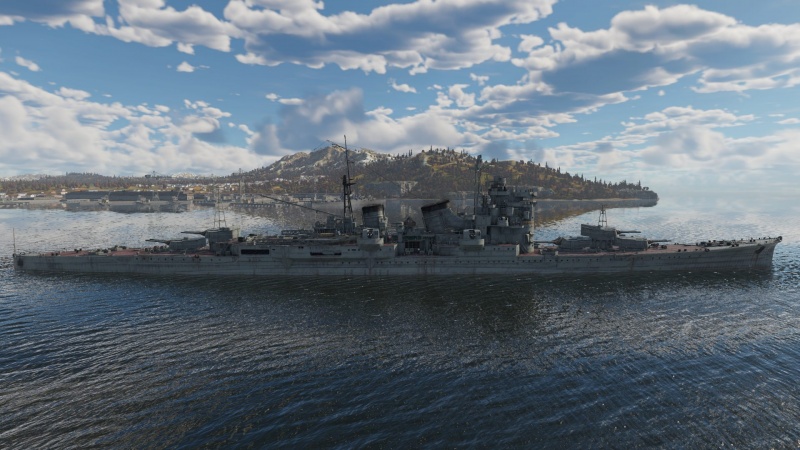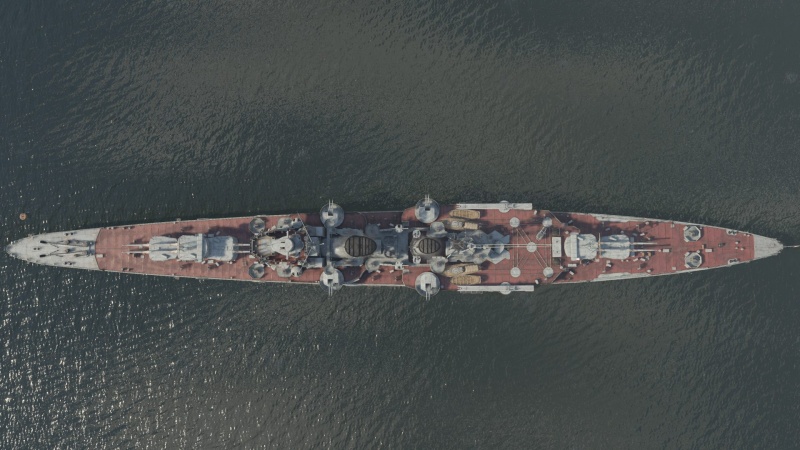IJN Haguro
Contents
Description
Haguro (羽黒, namesake: Mount Haguro) was a Japanese heavy cruiser, the third of the Myoko-class, laid down at the Mitsubishi shipyard in March 1925, launched in March 1928, and entering service in April 1929. She underwent modernization in the early 1930s and again in 1939, participated in various operations including troop transfers and patrols in China from 1936 to 1937. During World War II, Haguro actively fought in the Pacific theater, notably in the Battle of the Java Sea in February 1942 where she played a key role in sinking eight Allied warships, including the British cruiser HMS Exeter. She also took part in the Battle of the Coral Sea, the Battle of Midway, and the Battle off Samar during the Leyte Gulf engagements. In May 1945, while attempting to deliver supplies to the Andaman Islands, Haguro was intercepted by British destroyers in the Strait of Malacca and, after being hit by torpedoes, sank. Her wreck was discovered in 2002 by the divers from the MV Empress, she sits 67 meters below the surface.
The Myoko-class, IJN Haguro, 1944 was introduced in Update "Seek & Destroy", in a number of ways it's typical for early Japanese heavy cruisers, however, thanks to modernization, it received many of the advantages of later ships, most notably an excellent anti-air battery, improved secondary guns and much better survivability than the previous vessels, although it still lags behind some of the foreign contemporaries.
General info
Survivability and armour
Talk about the vehicle's armour. Note the most well-defended and most vulnerable zones, e.g. the ammo magazine. Evaluate the composition of components and assemblies responsible for movement and manoeuvrability. Evaluate the survivability of the primary and secondary armaments separately. Don't forget to mention the size of the crew, which plays an important role in fleet mechanics. Save tips on preserving survivability for the "Usage in battles" section. If necessary, use a graphical template to show the most well-protected or most vulnerable points in the armour.
Mobility
Write about the ship's mobility. Evaluate its power and manoeuvrability, rudder rerouting speed, stopping speed at full tilt, with its maximum forward and reverse speed.
| Mobility Characteristics | |||
|---|---|---|---|
| Game Mode | Upgrade Status | Maximum Speed (km/h) | |
| Forward | Reverse | ||
| AB | |||
| Upgraded | |||
| RB/SB | |||
| Upgraded | |||
Modifications and economy
Armament
Primary armament
Provide information about the characteristics of the primary armament. Evaluate their efficacy in battle based on their reload speed, ballistics and the capacity of their shells. Add a link to the main article about the weapon: {{main|Weapon name (calibre)}}. Broadly describe the ammunition available for the primary armament, and provide recommendations on how to use it and which ammunition to choose.
| Penetration statistics | |||||||
|---|---|---|---|---|---|---|---|
| Ammunition | Type of warhead |
Penetration @ 0° Angle of Attack (mm) | |||||
| 1,000 m | 2,500 m | 5,000 m | 7,500 m | 10,000 m | 15,000 m | ||
| Type 0 HE | HE | 61 | 61 | 61 | 61 | 61 | 61 |
| Type 91 AP | APHEBC | 362 | 321 | 263 | 218 | 182 | 139 |
| Type 0 HE-TF | HE-TF | 61 | 61 | 61 | 61 | 61 | 61 |
| Shell details | ||||||||||||
|---|---|---|---|---|---|---|---|---|---|---|---|---|
| Ammunition | Type of warhead |
Velocity (m/s) |
Projectile mass (kg) |
Fuse delay (s) |
Fuse sensitivity (mm) |
Explosive mass (TNT equivalent) (kg) |
Ricochet | |||||
| 0% | 50% | 100% | ||||||||||
| Type 0 HE | HE | 835 | 125.4 | 0 | 0.1 | 8.57 | 79° | 80° | 81° | |||
| Type 91 AP | APHEBC | 835 | 125.85 | 0.05 | 9 | 3.26 | 48° | 63° | 71° | |||
| Type 0 HE-TF | HE-TF | 835 | 125.4 | 0 | 0.1 | 8.57 | 79° | 80° | 81° | |||
Secondary armament
Some ships are fitted with weapons of various calibres. Secondary armaments are defined as weapons chosen with the control Select secondary weapon. Evaluate the secondary armaments and give advice on how to use them. Describe the ammunition available for the secondary armament. Provide recommendations on how to use them and which ammunition to choose. Remember that any anti-air armament, even heavy calibre weapons, belong in the next section. If there is no secondary armament, remove this section.
| Penetration statistics | |||||||
|---|---|---|---|---|---|---|---|
| Ammunition | Type of warhead |
Penetration @ 0° Angle of Attack (mm) | |||||
| 1,000 m | 2,500 m | 5,000 m | 7,500 m | 10,000 m | 15,000 m | ||
| 127 mm HE | HE | 25 | 25 | 25 | 25 | 25 | 25 |
| 127 mm HE-TF | HE-TF | 25 | 25 | 25 | 25 | 25 | 25 |
| Shell details | ||||||||||||
|---|---|---|---|---|---|---|---|---|---|---|---|---|
| Ammunition | Type of warhead |
Velocity (m/s) |
Projectile mass (kg) |
Fuse delay (m) |
Fuse sensitivity (mm) |
Explosive mass (TNT equivalent) (kg) |
Ricochet | |||||
| 0% | 50% | 100% | ||||||||||
| 127 mm HE | HE | 720 | 23 | 0 | 0.1 | 1.96 | 79° | 80° | 81° | |||
| 127 mm HE-TF | HE-TF | 720 | 23 | 0 | 0.1 | 1.96 | 79° | 80° | 81° | |||
Anti-aircraft armament
An important part of the ship's armament responsible for air defence. Anti-aircraft armament is defined by the weapon chosen with the control Select anti-aircraft weapons. Talk about the ship's anti-air cannons and machine guns, the number of guns and their positions, their effective range, and about their overall effectiveness – including against surface targets. If there are no anti-aircraft armaments, remove this section.
Additional armament
Describe the available additional armaments of the ship: depth charges, mines, torpedoes. Talk about their positions, available ammunition and launch features such as dead zones of torpedoes. If there is no additional armament, remove this section.
Scout plane
Usage in battles
Describe the technique of using this ship, the characteristics of her use in a team and tips on strategy. Abstain from writing an entire guide – don't try to provide a single point of view, but give the reader food for thought. Talk about the most dangerous opponents for this vehicle and provide recommendations on fighting them. If necessary, note the specifics of playing with this vehicle in various modes (AB, RB, SB).
Pros and cons
Pros:
- Increased number of primary guns in comparison to its tech tree predecessors IJN Furutaka and IJN Aoba
- Carries a total of 16 Type 93 Model 1, Mod 2 torpedoes that have an extraordinary explosive mass
- Access to search radar as well as two E13A1 scout planes
- 48 Type 96 autocannons offer decent anti-air capabilities
Cons:
- Very large target, even some battleships seem tiny in comparison to IJN Haguro
- Unimpressive manoeuvrability makes it difficult to dodge enemy gunfire - even from 10+ km distance
- Overall thin armour - destroyers with SAP shells become a great threat at short distance, especially if aimed at turrets or magazines
- Quite problematic firing angles for one of the turrets, being able to use it requires exposing the whole side of the ship
History
Describe the history of the creation and combat usage of the ship in more detail than in the introduction. If the historical reference turns out to be too long, take it to a separate article, taking a link to the article about the ship and adding a block "/History" (example: https://wiki.warthunder.com/(Ship-name)/History) and add a link to it here using the main template. Be sure to reference text and sources by using <ref></ref>, as well as adding them at the end of the article with <references />. This section may also include the ship's dev blog entry (if applicable) and the in-game encyclopedia description (under === In-game description ===, also if applicable).
Media
Excellent additions to the article would be video guides, screenshots from the game, and photos.
See also
Links to articles on the War Thunder Wiki that you think will be useful for the reader, for example:
- reference to the series of the ship;
- links to approximate analogues of other nations and research trees.
External links
- [Wikipedia] Japanese cruiser Haguro
- [大日本帝国軍 主要兵器] 羽黒【妙高型重巡洋艦 四番艦】 Haguro【Myoko-class heavy cruiser Forth】
- [Combined Fleet] IJN HAGURO: Tabular Record of Movement
- [Naval Encyclopedia] Nachi class Cruisers (1927)
- [The Pacific War Online Encyclopedia] Myoko Class, Japanese Heavy Cruisers
- [WW2 Cruisers] Myoko Class Heavy Cruiser
- [World War II Database] Haguro
- [Navypedia] NACHI heavy cruisers (1928 - 1929)
- [Pacific Wreck] Haguro 羽黒
| Mitsubishi Shipbuilding Company Ltd. | |
|---|---|
| Light Cruisers (CL) | |
| Kuma-class | IJN Tama |
| Sendai-class | IJN Sendai |
| Mogami-class | IJN Mikuma |
| Heavy Cruisers (CA) | |
| Furutaka-class | IJN Furutaka |
| Aoba-class | IJN Aoba |
| Myōkō-class | IJN Haguro |
| Tone-class | IJN Tone |
| Battleships (BB) | |
| Ise-class | IJN Hyuga |
| See also | Mitsubishi Heavy Industries, Ltd. (Post-War) |
| Japan heavy cruisers | |
|---|---|
| Furutaka-class | IJN Furutaka · IJN Kako |
| Aoba-class | IJN Aoba |
| Myōkō-class | IJN Myoko · IJN Haguro |
| Mogami-class | IJN Mogami |
| Tone-class | IJN Tone |







